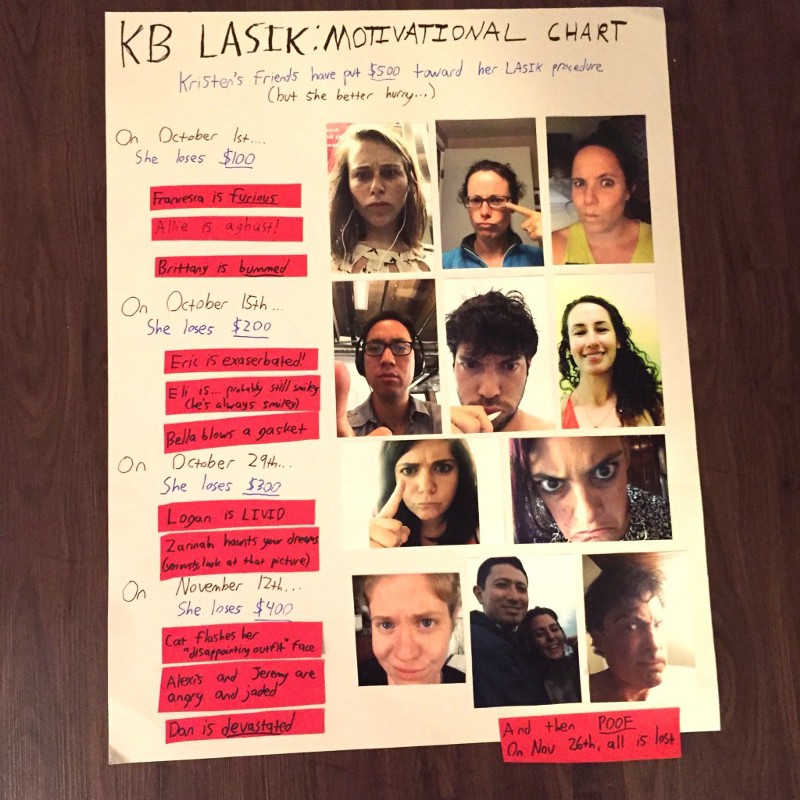My lovely friend Kristen Berman hates wearing her contact lenses. In fact, she has wanted to get LASIK for some time. However, like the rest of us often do, she has fallen victim to that oh-so-awful thing called procrastination. LASIK sounds great and all, yes, she’ll get to it…later. Sound familiar? (“I’m going to start my diet…tomorrow. I’m going to start saving more…next month”…etc).
Another important detail about Kristen: She works with behavioral economist Dan Ariely. So when Kristen’s thoughtful and caring boyfriend Phil wanted to figure out a way to help her out of her procrastination rut, he turned to the master himself for advice.
Here’s the incentive scheme they put into place: Phil got a bunch of Kristen’s friends to agree to contribute to her surgery, $500 in total. But there’s a catch. If Kristen gets her surgery right away, great — she gets all $500. But, if she lets too much time slip without getting the surgery, the $500 gets reduced. On October 1st, she loses $100. On the 15th, she loses $200, etc. By November 26th, all of the money disappears.

Phil made a chart that details all of the conditions. It also includes photographs of her friends and their sad or angry faces at each passing week. The captions say things like: “Francesca is furious” and “Dan is devastated.”
Why This Is Brilliant
As a behavioral economist and psychologist, Dan knows better than anyone the power of loss aversion and social incentives. In this case, both are at play. Loss aversion means that it pains us more to lose something than it makes us happy to gain something. In other words, we value something more once we own it. So Kristen is much more likely to act on the potential pain of losing the $500 vs. the pleasure of receiving it. Note the detail on how the flyer is worded. Technically it could have started with “you get $500 toward your surgery,” followed by “you get $400,” “you get $300,” etc as time passed. It might seem like a detail but it’s much more powerful to frame it as a loss instead.
Also, using the social element in this incentive scheme magnifies its power. Under this scheme, if Kristen doesn’t get LASIK she is not just disappointing Phil, but all of her friends as well. Using the visual of their photographs solidifies the emotional effect.
How You Can Build Similar Incentive Schemes
Are you looking to motivate your employees to be more productive? How about your children, perhaps to do their homework? How about yourself, to perhaps go to the gym?
Here’s an example of how to use loss aversion at work: I recently ran a small-scale experiment with a company using loss aversion in their employee incentive plan. Employees were randomly assigned to be pre-paid their bonuses at the beginning of the month, or to receive them at the end of the month. Pre-paid employees who did not hit their sales targets had to pay back the amount owed. After one month, we switched groups. In each case, the prepaid group outperformed the normally paid group (by 50% for the first group and 32% for the second group). We also measured employee satisfaction before, during, and after the experiment and saw no decrease.
As for your children, your significant other, or yourself, loss aversion also works. I imagine some of you are already using incentives to get your kids to do certain things; try framing the reward as a loss vs. a gain. Warning: your kids probably need to be a certain age for this to work; I don’t recommend this with toddlers. For a social element, consider either using photos or sharing your goals with others or in some public way, similar to what I suggested in my post on commitment devices.
A Comment From Dan
Think that using incentives is manipulation? Maybe. In this case, Kristen herself wants to get LASIK, and in the long run it will be a benefit to her. In the end, procrastination is a powerful force that affects us all, so if there are creative ways to help people do something good for themselves in the long run, why not? Here’s what Dan adds in his advice to Phil: “Of course, if you do this, you should expect that at some point [Kristen] will set up some incentives for things that she wants you to do. Try to accept these cheerfully in the spirit of making your relationship more exciting and productive.” Love it!
Originally published at behaviorly.com on August 13, 2015.
Want to learn more about behavioral design? Join our Behavioral Economics Bootcamp today.
